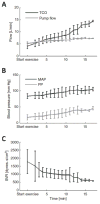Left ventricular assist device-induced reverse remodeling: it's not just about myocardial recovery
- PMID: 27871197
- PMCID: PMC5541390
- DOI: 10.1080/17434440.2017.1262762
Left ventricular assist device-induced reverse remodeling: it's not just about myocardial recovery
Abstract
The abnormal structure, function and molecular makeup of dilated cardiomyopathic hearts can be partially normalized in patients supported by a left ventricular assist device (LVAD), a process called reverse remodeling. This leads to recovery of function in many patients, though the rate of full recovery is low and in many cases is temporary, leading to the concept of heart failure remission, rather than recovery. Areas covered: We summarize data indicative of ventricular reverse remodeling, recovery and remission during LVAD support. These terms were used in searches performed in Pubmed. Duplication of topics covered in depth in prior review articles were avoided. Expert commentary: Although most patients undergoing mechanical circulatory support (MCS) show a significant degree of reverse remodeling, very few exhibit sufficiently improved function to justify device explantation, and many from whom LVADs have been explanted have relapsed back to the original heart failure phenotype. Future research has the potential to clarify the ideal combination of pharmacological, cell, gene, and mechanical therapies that would maximize recovery of function which has the potential to improve exercise tolerance of patients while on support, and to achieve a higher degree of myocardial recovery that is more likely to persist after device removal.
Keywords: Heart failure; exercise tolerance; extracellular matrix; heart assist device; inflammation; micro-RNAs; myocardial remission; sympathetic activation.
Figures






References
-
- Jessup M, Brozena S. Heart failure. N Engl J Med. 2003;348:2007–18. - PubMed
-
- Pfeffer JM, Fischer TA, Pfeffer MA. Angiotensin-converting enzyme inhibition and ventricular remodeling after myocardial infarction. Annu Rev Physiol. 1995;57:805–26. - PubMed
-
- Effect of enalapril on survival in patients with reduced left ventricular ejection fractions and congestive heart failure. The SOLVD Investigators. N Engl J Med. 1991;325:293–302. - PubMed
-
- Pfeffer MA, Braunwald E, Moye LA, et al. Effect of captopril on mortality and morbidity in patients with left ventricular dysfunction after myocardial infarction. Resuts of the survival and ventricular enlargement trial. The SAVE Investigators. N Engl J Med. 1993;327:669–77. - PubMed
-
- Levin HR, Oz MC, Chen JM, Packer MP, Rose EA, Burkhoff D. Reversal of chronic ventricular dilation in patients with end-stage cardiomyopathy by prolonged mechanical unloading. Circulation. 1995;91:2717–20. This was the first paper to report the impact of LVAD support on the end-diastolic pressure-volume relationship and established the concept of LVAD-induced reverse remodeling. - PubMed
Publication types
MeSH terms
Grants and funding
LinkOut - more resources
Full Text Sources
Other Literature Sources
